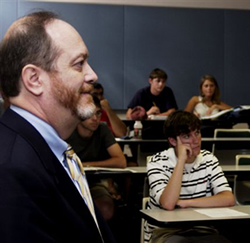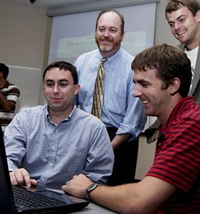M.B.A./M.S. Program Works on Integrating Today’s Technologies into Daily Life

Call it what you want – ubiquitous computing, pervasive computing, physical computing, tangible media – but patent applications now making their way through the approval process could mean big things for The University of Alabama and its M.B.A./M.S. dual degree program for Enterprise Consulting and the computer-based honors program.
The foundation for the patent applications is the work being conducted as part of the University’s strategic initiative to be a student-centered research university. The projects are coordinated by Dr. David Hale, director of UA’s Management Information Systems program, and Dr. Shane Sharpe, director of the Computer-Based Honors Program. The student-faculty teams are collectively responsible for developing the underlying intellectual property, the process of protecting their ideas, and establishing business models.
“Our students are jumping into the IP game with both feet,” Hale said. “They see the value of being innovators and entrepreneurs.” The faculty and students will jointly own the patents and the University will share in the proceeds from the patents. This is conducted under the University’s Alabama Innovation, Mentoring and Entrepreneur Center.
As Hale explained, the patent applications integrate a myriad of information technologies that push the envelope of how computing is used in our daily work and home lives. In all these cases, the information technology has become a natural part of how we live and do our work, and it is already available in such a fashion that the technology is for the most part invisible.
Here’s a look at the first three patent applications:
Non-Invasive Material Inspection and Routing
A major concern in today’s fast paced business environment is ensuring that parts and products are where they are supposed to be at the time they are supposed to be there. For example, let’s say The University of Alabama football team needs a crimson helmet with the number 14 on it in time for Saturday’s game, and kickoff is 12 hours away.
The university athletic department notifies the helmet manufacturer and the company goes to work finding the right helmet in a warehouse full of helmets.
Using a process now being patented by The University of Alabama, the forklift operator in the warehouse will climb onto his forklift, fire up his RFID equipment (radio frequency identification, a generic term for technologies that use radio waves to automatically identify people or objects) and cruise through the warehouse.
A flip-around head mounted lens, which fits in front of the operator’s eye, displays a computer generated image but still allows the operator clear vision.
The operator, using a transmitter in his glove, connects with a computer on which the helmet storage location has already been filed. The computer then responds via wireless technology to the forklift operator, directing him via infrared beams to the pallet and box where the helmet is stored.
That’s the simplified short version. Hale is the project sponsor, but the bulk of the work was done by students Craig Kersteins, Nic Allums, Lee Edwards and Meg Lawson.
“This system allows the operator to perform the job faster, safer and cheaper with fewer mistakes,” Hale said. The students are now working on the prospectus needed to sell the resulting IP licenses.
“The project sparked a great deal of entrepreneurial spirit and enhanced creativity throughout the Enterprise Consulting program,” he said.
Following this pattern, students Guido Arroyo, Payton Bibb, Cass Brown, Jennifer Byrd, Brad Daughdrill, Ken Gunnels, Ryan Ingraham, Payal Modi, Dylan Rebillot, and Cliff Stewart have developed the following IP concepts.
Smart Speed

Smart Speed is a continuous passive driver support system that tells the driver the safest speed at which to drive given the current ambient conditions. The system will consider the weather, posted speed limits, road conditions, vehicle dynamics and special conditions.
The system will incorporate biometric technology to identify the driver and automatically make adjustments to fit, such as seat position, mirror adjustments and steering column height.
The system also will incorporate an internal vehicle monitoring system to detect malfunctions, notify the driver of necessary maintenance and pending problem areas, as well as a remote human assistance feature. Voice commands will be used to activate any features in the car.
The system will use GPS technology to map the road and determine speed limits and the driver would be notified visually and audibly when the limit is exceeded.
The system will consider wind, rain, ice, smog, fog, haze, smoke and light via integrated vehicle sensors. GPS technology will provide highway information such as curves, steep hills, bridges, merging zones and high accident areas.
Use of Smart Speed will result in safer driving (both directly and indirectly, through its use as a teaching tool for young drivers), as well as possible lower insurance premiums for those who use it. The auto manufacturer would benefit through less warranty work.
ADAPT (Analog and Digital Adaptive Performance Technologies)
ADAPT is an automotive management system that allows centralized control of the way an automobile is used.
For example, parents of young drivers could use the system to limit the number of passengers they can carry, thereby reducing the chance of distraction. Central control could also monitor and control the speed of the car, and it could change the gear ratio to minimize high performance. The system also could be used to allow an elderly person to still drive and maintain a sense of independence. The system could be used to establish geographic limits to let the central control know the whereabouts of the vehicle. The performance characteristics of the car could be changed for long trips to improve the vehicle’s economy.
ADAPT would use various personal characteristics to designate the driver or the passenger, and it could be used to establish times when certain people could or could not drive the car.
The technology would benefit auto rental agencies, fleet managers and parents.
Further Reading